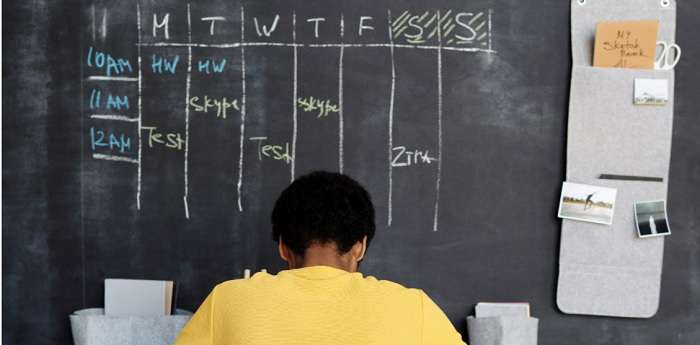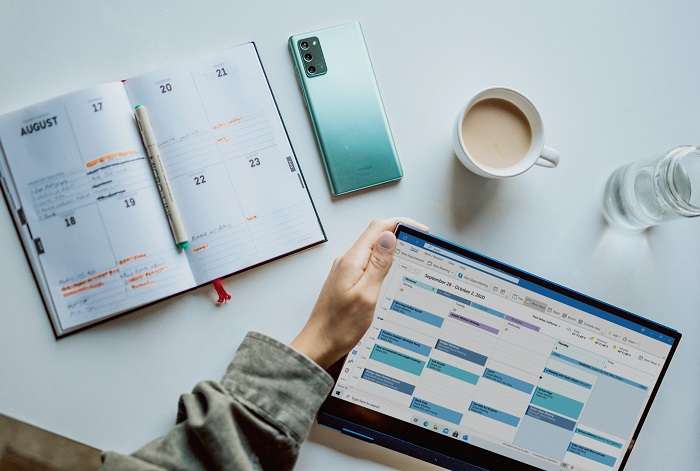
Students lead increasingly busy lives, trying to balance school, part-time jobs, and their personal and social lives. But, time blocking for students could be the key to finally finding the right balance and not feeling so overwhelmed. This proven technique helps you juggle everything without forgetting anything.
How Time Blocking Works
Time blocking is a relatively simple method that divides your time each day into blocks. For instance, as a student, you might create a block of time from 8 AM to 3 PM for school, 3 PM to 4 PM for an extracurricular activity, 4 PM to 6 PM for a part-time job, and 6 PM to 8 PM for homework and studying. Naturally, how you divide things up is completely up to you.

Unlike your common to-do list, time blocking creates a schedule for when you’ll complete each thing on your list. Instead of haphazardly picking tasks and doing them, you start your day with a set order and you’re able to handle all your tasks based on your pre-set schedule.
Benefits of Time Blocking for Students
Time blocking works for just about anyone. For students, it’s all about maintaining priorities, avoid distractions, and ensuring they don’t neglect any important areas of their lives.

Some of the top benefits include:
- Set a clear priority for each block of time to avoid trying to multi-task or wasting time deciding on what task to tackle next
- Makes it easier to plan ahead for extra activities, such as school events, nights out with friends, etc.
- Allows you to set blocks of time for the most important areas of your life, such as school, family, work, and friends
- Helps reduce procrastination by setting hard deadlines on when you must finish a task
- Reduces stress and anxiety by planning your day ahead of time and just following your day block by block
- Improves focus and productivity by having a single task per block
- Improves time management skills
What You’ll Need
All you need is a calendar that lists each day hour by hour. Your calendar can be digital or physical. Planners are perfect for to use for time blocking for students. Something like UtyTrees To Do List Notebook works well and it’s easy to stick in a backpack to take with you.

If you’re using a physical planner or calendar, you might want to use pens or highlighters in different colors to quickly distinguish between categories. For instance, everything related to school might be in red, work time may be blue, relaxation time might be purple, and going out with friends could be green. This way you know what type of task is coming next based on the color.
Naturally, you probably have your phone with you most of the time. Take advantage of the convenience to create your schedule. Google Calendar is an easy to use and free option. You can color-code each block of time as much as you want. Or even get more creative by using calendar templates for Google Sheets.
You can also use an app if you want. TickTick is one of the most popular, especially with multiple calendar views. TimeTune and Boosted are also nice, but they’re only available for Android.
Using Time Blocking Effectively
At first, time blocking might seem overwhelming. After all, you’re supposed to account for every hour of your day. However, it’s perfectly fine to assign a block of time as “free time” if you don’t have any pressing tasks. Then, if something does come up, you’ll have a place to schedule it.

To get the most benefits from time blocking for students, try the following:
- Decide what time each day or week you’ll devote to time blocking. You can do this every night, each morning, or even just once a week. However, set aside roughly 15-30 minutes to do this.
- Start by filling in blocks for your most important tasks. These might include studying, homework, school events, and work. These are things that must be done. Consider color-coding tasks by type and priority.
- Be realistic with your time. The object of time blocking is to improve your time management. However, if you only set aside 15 minutes for a homework assignment that you know will take 30-45 minutes, you’ll just create more stress for yourself. As you assign blocks, be realistic with the amount of time a task takes.
- Schedule breaks. Don’t fill in every single block with work, school, and other commitments. Students need breaks. Schedule time for a favorite hobby, watching TV, or any other self-care activity.
- Ensure you schedule a balance of school, work, and personal time. All three are equally important. Time blocking lets you quickly see if you need to readjust your schedule and priorities for a more balanced life.
- Commit to the plan. This is the hardest part, but once you get used to only focusing on your specific task during a block of time, you’ll quickly feel more focused and realize you’re getting more accomplished in less time.
- Modify your schedule as needed. Time blocking doesn’t have to be super rigid. After all, unexpected situations arise. It’s okay to be flexible. But, pay attention to areas where you seem to regularly finish early or late. Then, modify your schedule to better accommodate your needs.
Frequently Asked Questions
How can I keep better track of my time so I stay on schedule?
It’s easy to still get distracted or try to jump between tasks when you’re first starting with time blocking. To keep you more focused, consider using a timer app or using the Pomodoro technique to create a more strict deadline.
How far ahead should I create my calendar?
If you know you have a task that happens every day or week for months, go ahead and block it in. For most students, you’ll likely want to stick to no more than one week ahead.
Image credit: Unsplash











